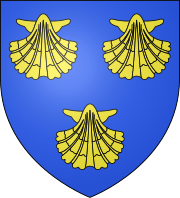Pringle baronets
| Baronetcy of Pringle of Stichill | |
|---|---|

Coat of arms of the Pringles of Stichill: Azure, three escallops, or
|
|
| Creation date | 5 January 1683 |
| Monarch | Charles II |
| Peerage | Baronetage of Nova Scotia |
| First holder | Sir Robert Pringle, 1st Baronet |
| Present holder | Sir Norman Murray Pringle, 10th Baronet |
| Heir apparent | Alastair Steuart Ronald Pringle |
| Remainder to | The male heirs of his [Robert Pringle of Stichill] body |
| Former seat(s) | Stitchill House, Roxburghshire Undermount, Bonchurch, Isle of Wight |
There have been two baronetcies created for members of the Scottish Pringle family, one in the Baronetage of Nova Scotia and one in the Baronetage of Great Britain. As of 2015, one creation is extant.
The Pringle Baronetcy, of Stichill in the County of Roxburgh, was created in the Baronetage of Nova Scotia on 5 January 1683 for Robert Pringle. The fourth Baronet sat as Member of Parliament for Berwickshire.
The Pringle Baronetcy, of Pall Mall, was created in the Baronetage of Great Britain on 5 June 1766 for the physician John Pringle. He was the youngest son of the second Baronet of the 1673 creation. The title became extinct on his death in 1782.
The 10th Baronet was Commandant General Royal Marines from 1981 to 1985. After his death in 2013, the title was claimed by his eldest son, Simon. However, DNA testing, originally gathered to determine who the current clan chief of the Clan Pringle (dormant since 1738) should be, showed that the 10th baronet was not genetically related to the rest of the Pringle clan. Steuart's first cousin (and therefore Simon's first cousin once removed) Norman Murray Pringle (born 3 August 1941) contested the title, on the basis that the 9th baronet should have been his father, Ronald Steuart Pringle (26 April 1905 – 24 July 1968), the younger, legitimate son of the 8th baronet. While the dispute continued, the baronetcy was dormant, due to the conflicting claims of Murray Pringle and Simon Pringle since neither had proven their right of succession to the baronetcy over the other. As a consequence neither was entered on the Official Roll of the Baronetage.
The Queen, acting under the Judicial Committee Act 1833, referred the matter to the Judicial Committee of the Privy Council, which held its hearings on the matter in November 2015 and January 2016. It delivered its ruling on 20 June 2016, determining that DNA evidence proved that Sir Norman Hamilton Pringle, 9th Baronet, was conceived adulterously and was not the son of Sir Norman Robert Pringle, 8th Baronet. As such, on the latter's death, the baronetcy rightfully passed to his first biological son, Ronald Steuart Pringle, and then to his son, Norman Murray Pringle.
...
Wikipedia
